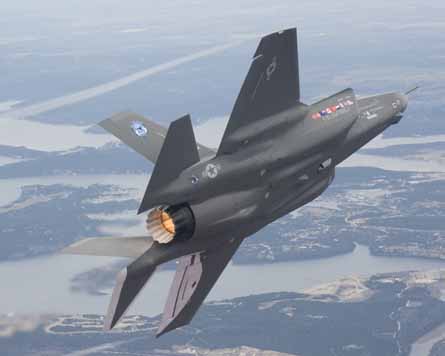War-related spending will pay for additional fighters, airlifters and rotorcraft if Congress approves Pentagon's plans
A trio of US defence spending requests sent to Congress last week promise stability for most aviation programmes, a windfall for some and the end of the line for a few. War-related funding requests add 148 fighters, airlifters and rotorcraft beyond those budgeted for in fiscal years 2007 and 2008.
Lockheed Martin's F-35 Joint Strike Fighter is funded, but at lower production rates than planned, and the Department of Defense will again try to cancel its General Electric/Rolls-Royce F136 alternative engine. Lockheed's C-130J tactical airlifter is a major beneficiary of additional war-related funding requests, but the DoD still wants no more Boeing C-17s, budgeting only to mothball the production tooling.
|
|---|
F-35 production is trimmed, and alternative engine is axed - again |
Congress last year overturned the Pentagon's plans to kill the F136 and end C-17 procurement at 180 aircraft, and powerful senators were quick to fire warning shots over the DoD's bows when it reintroduced the proposals as part of a combined $623.1 billion in defence spending requests sent to the Hill last week.
The staggering total is made up of $481.4 billion in "normal" FY2008 funding - up almost 11% from FY2007 - plus another $141.7 billion to fund the "global war on terror" (GWOT) in FY2008. Completing the trio of requests is a $93.4 billion emergency supplemental request for FY2007 funding to cover operations in Afghanistan and Iraq, on top of the $70 billion approved by Congress last year.
The FY2008 budget sets out the DoD's procurement planning for the next six years, to FY2013, and includes some significant adjustments. But the emergency supplemental and GWOT requests modify those plans by funding substantial numbers of aircraft in FY2007 and FY2008 to replace those lost or worn out in the war.
Perhaps most significant is the cut in the number of F-35s the US Air Force, Navy and Marine Corps plan to buy in the early years of the programme. Procurement for FY2008-13 is trimmed to 140 aircraft for the USAF, and to 133 for the USN/USMC. So far, the overall numbers planned have not changed, although the air force's procurement total is now listed as "to be decided".
The cutbacks will affect the production ramp-up, and the cost of early aircraft - including those for international customers. For FY2007, Congress cut the initial batch of F-35s from five to two USAF aircraft.
The FY2008 budget request funds six USAF and six USMC aircraft, and the six-year plan sees annual production building to 48 for the USAF and 42 for the USN/USMC by FY2013 - slower than planned. The war-related requests seek three extra USAF F-35s, which will help the early ramp rate.
Because of delays to the F-35 carrier version, the US Navy wants additional Boeing F/A-18E/Fs. Planned procurement is increased from 462 to 494 aircraft, but the number of electronic-attack EA-18Gs is trimmed from 90 to 80. The navy is also seeking six -18Gs in the FY2007 emergency supplemental and 12 E/Fs in the FY2008 GWOT request - which does not change overall numbers, but accelerates deliveries.
Some of the biggest budget changes are in the airlift accounts. The supplemental and GWOT requests add no fewer than 22 USAF C-130Js and seven USMC KC-130Js. The FY2008-13 budget plan also includes funds to begin replacing HC/MC-130 combat rescue tankers flown by US Air Force Special Operations Command. Also funded are the Joint Cargo Aircraft - 44 for the US Army and 48 for the USAF over the six years - and KC-X replacement tanker, at 14 a year.
Not surprisingly, given mounting losses, helicopters feature strongly in the war-related requests - the US Army seeks an additional 46 Sikorsky UH-60s and 25 Boeing CH-47s over the two years. Also, despite programme delays, the army wants 35 additional Bell ARH-70s - and has increased planned procurement of the new armed reconnaissance helicopter from 368 to 512.
The US Navy wants nine Sikorsky MH-60S/Rs and the USMC six Bell UH-1Y/AH-1Zs as wartime replacements - and the FY2008 budget suggests the enlargement of the marine corps could increase the number of upgraded H-1s needed. The war-related requests include two USMC Bell Boeing MV-22s and six USAF combat-rescue CV-22s - but V-22 procurement is held to 35 a year from FY2009.
US Air Force unmanned air vehicle accounts also see some changes. The FY2007 supplemental seeks 30 additional General Atomics MQ-1 Predators, but the budget reduces procurement to 160 over the FY2008-13 period while that of the improved MQ-9 Reaper is increased to 51.
Procurement of the Northrop Grumman RQ-4 Global Hawk is held to five a year over the six-year period, instead of increasing as planned.
Overall, while funding for fighter, rotorcraft and UAV programmes increases, spending on aircraft across the services would decline slightly from FY2007 to FY2008 were it not for the war-related requests. The question now is how much the bump in procurement will spread into later years to sustain production rates.
Source: Flight International

















